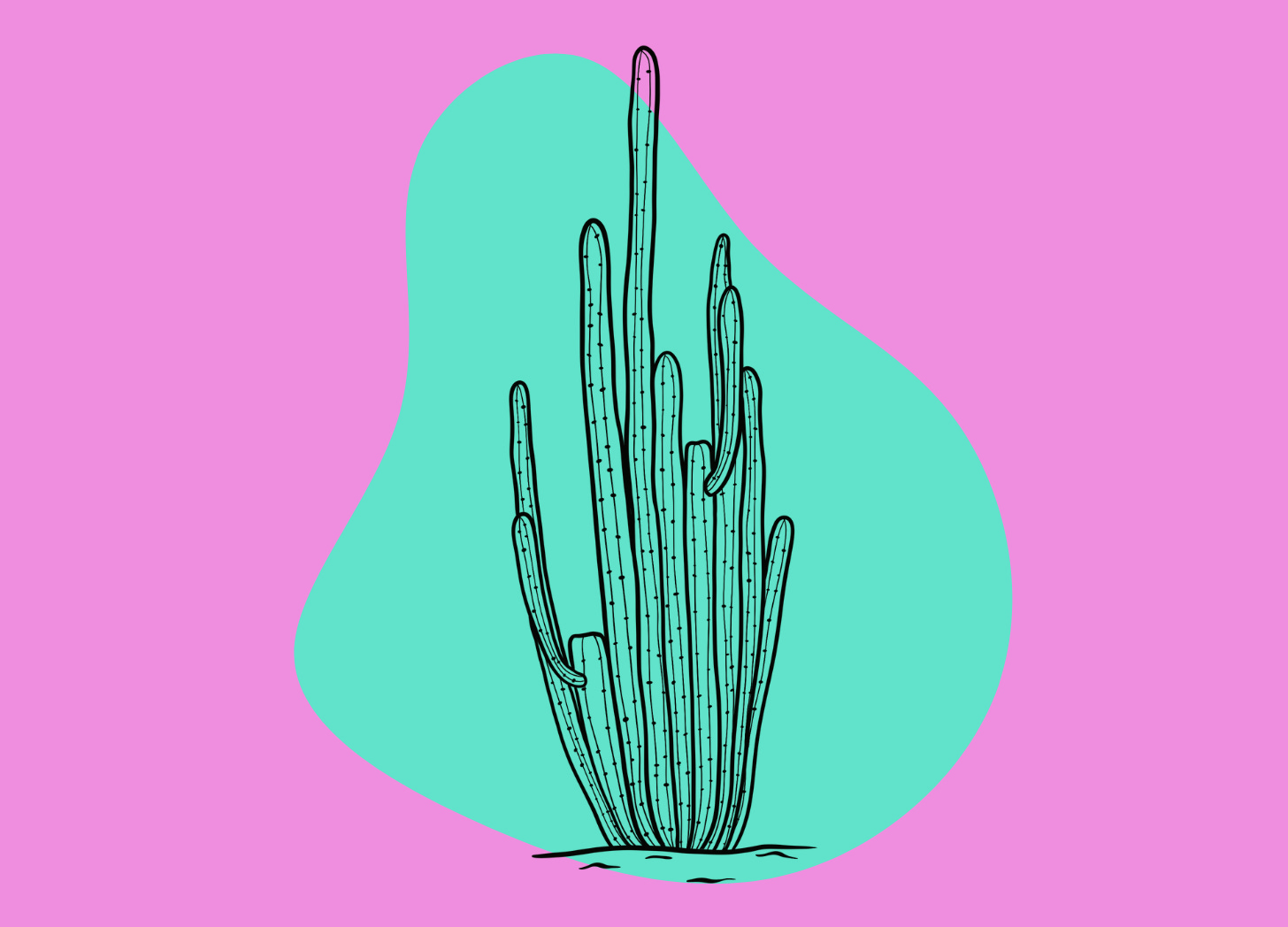Grow Tall, San Pedro: The Resilient Cactus' Fight for Survival 🌵
Despite its "sustainable" reputation, psychotourism has decimated wild populations of San Pedro in just 40 years. Here's what we can do about it...
San Pedro, or Huachuma, a columnar mescaline-containing cactus, is one of the most underrated natural psychedelics on Earth.
Mescaline-containing cacti have been credited as the inspiration behind innovative writers and philosophers like Alan Watts and Aldous Huxley to chemists like Alexander Shulgin and Nick Sand.
But more importantly, mescaline-containing cacti like San Pedro have been used as an important medicine and sacrament by the Moche, Nazca, Chavín, Quechua, and numerous other indigenous groups for at least 3000 years.
Its use even survived through Spanish colonialism — to some degree.
However, unlike the isolated tribes using ayahuasca in the jungle, missionaries succeeded in creating a stigma against psychedelics throughout much of Peru. As a result, many communities no longer see the cactus as a traditional and valuable medicine.
This disconnect means the cactus is harvested by locals and brought to markets where it can be sold for a profit. The cacti are shipped to markets in Cucso to be sold to retreat centers or to tourists for substantially higher prices paid in American dollars.
Others buy dried cactus powder in bulk and flip it online for hundreds of dollars per kg.
The San Pedro cactus don't grow as easily in the Cusco region, so retreats buy the cacti cheap from Northern Peru and hold ceremonies that gross hundreds or thousands of dollars each.
Abroad, in North America and Europe, facilitators earn huge profits on plants harvested by locals in Northern Peru who get nothing in return.
Josip Orlovac, a Peruvian curandero and co-founder of Huachuma Collective, a nonprofit dedicated to the bio-cultural regeneration of huachuma, recounts one of his Meastro's passing away from tuberculosis in poverty. The towns harvesting San Pedro no longer have curanderos using the plant, schools, books, or healthcare. "It is out of balance," Josip explains that in a tragic irony, San Pedro actually teaches balance.
Together Meastro Filipe Pereda and Laurel Anne Sugden, a Ph.D. researcher focused on multidisciplinary research of huachuma, have created a nonprofit that has pledged to plant 1 million San Pedro cacti in partnership with Andean communities.
The organization weaves planting the cactus with regenerating relationships with the plant through education that reestablishes its value in the eyes of communities. By running workshops and bringing ready-to-plant cacti into villages, curiosity is being sparked in this ancient healing plant.
If you have a love for huachuma and want to give back to the communities in the Andes, donate through GoFundMe, follow on Instagram, and subscribe to their beautifully written Substack.
What Can You Do About It?
Follow Huachuma Collective & Support Their Cause
Grow Your Own San Pedro
Use synthetic mescaline instead
Ask Your Practitioner Where Their San Pedro Comes From
Share This Information
Getting to Know San Pedro
The San Pedro cactus (Echinopsis pachanoi or Trichocereus pachanoi) is native to the mountainous regions of South America. It can be found growing as high as 3000 meters in elevation on the Eastern Slopes of the Andes in Argentina, Colombia, Ecuador, Peru, Bolivia, Venezuela, and Chile.
San Pedro grows quickly (for a cactus), with mature specimens often reaching heights of 12 meters (40 ft) tall. Under perfect conditions, San Pedro can grow roughly 1–2 feet per year once established. Compare this to something like Peyote, which takes 10–15 years to reach just 2–5 cm (1–2 inches) tall.
Once per year, usually in the warmer, wetter months, wild San Pedro populations develop large, white, beautifully aromatic flowers lasting about two days each. Over the course of a few weeks, a single cactus can produce dozens of these flowers — each one later giving rise to several hundred tiny black seeds.
San Pedro is one of the highest natural sources of the psychedelic phenethylamine, mescaline. The dried cactus contains up to 4.5% of this alkaloid, along with a series of related compounds.
The effects of mescaline are very similar to that of psilocybin from magic mushrooms or LSD (lysergic acid diethylamide).
Is San Pedro a "More Sustainable" Source of Mescaline Than Peyote?
All the problems associated with the over-harvesting of San Pedro are even further exaggerated when talking about Peyote.
Peyote contains higher concentrations of mescaline per gram (up to 6%) but is significantly smaller and grows much more slowly. It takes several peyote buttons to achieve psychoactive doses — each plant taking a decade or longer to get to that point.
Wildcrafting and using Peyote has been illegal in the United States for over 50 years already — but that hasn't stopped people from digging it up for themselves. Peyote is now listed as a vulnerable species, and populations are only continuing to diminish year after year.
Some argue that San Pedro is a more sustainable source of mescaline than Peyote because it grows much more quickly and is significantly larger. It contains lower concentrations of mescaline per gram, but this is more than made up for by the dramatically increased biomass overall.
While this is true to some extent, it's not as simple as it sounds.
The Huachuma Collective had this to say in one of their recent newsletters:
"There is a narrow band of effective habitat for wild San Pedro in the Andes. The plants grow in very specific zones which meet their precise elevation, temperature, and water needs. Many of those habitats have already been compromised by agricultural encroachment, road construction, and overharvesting. In the majority of active harvest zones, the plants are being cut at a faster rate than they are able to regenerate, and where old-growth plants still exist, they are being harvested disproportionately."
Like many ecosystems around the world, the Andes are being affected by climate change. New weather patterns in Peru can wreak havoc on cacti. With San Pedro's sensitivity to water, this species is especially susceptible.
Relying on San Pedro as a "sustainable" source of natural psychedelics is misguided.
The best way to use this plant sustainably is to grow it at home yourself.
San Pedro Traditions & Lineage
The spiritual traditions of the San Pedro cactus have largely been lost in Peru, save a few elders in the North who have trouble finding apprentices. Christian missionaries and colonial rule largely wiped out the indigenous ceremonial practice.
The remaining practitioners adopted syncretic traditions, which are disconnected from the land-based traditions.
Josip from Huachuma Collective describes how masters ask for permission and make offerings to the spirits of the lakes, mountains, and other plant teachers before cutting San Pedro. This connection with the land and the elements is essential to working effectively with the plant.
San Pedro is the "cactus of the four winds," meaning the elements of earth, water, air, and fire. Josip says learning how to use the elements takes much time, patience, and building a relationship with the plant.
But there still exists an opportunity to work with San Pedro meaningfully.
Huachuma Collective's message is simple — if you want to use San Pedro — grow it.
If you simply desire mescaline, take mescaline, but do not confuse it with sacred cacti.
The members of the collective urge people to stay away from the dried powder and to ask practitioners about their sources. Whenever possible, work with Peruvian or other Andean practitioners.
How to Grow San Pedro at Home
Just about anybody can grow San Pedro at home. It's relatively easy to grow and is much more tolerant to cooler, wetter weather than other species of cacti. These qualities make this plant an ideal houseplant for parts of Canada, Europe, and the United States that experience a much cooler temperature throughout the year.
Its native range is the high mountains of South America, where weather conditions are notoriously wet and harsh. High rainfall and a mix of very hot and very cold temperatures are the norm here.
Being adapted for this kind of climate, San Pedro is more resistant to overwatering and can handle much cooler temperatures than most other species of cacti.
With that said, San Pedro can still rot from being too wet, and it will die if exposed to too much heat during the summer without adequate amounts of water.
The most challenging aspect of cultivating this plant is ensuring it gets enough sunlight during the winter months.
San Pedro is susceptible to thinning (AKA etiolation) — which mainly occurs during the winter when the cactus can't get enough sunlight to support growth. The cactus will continue growing all year, but if light levels are too low, the top growing section will become thinner and may not be able to support the weight of future growth — eventually causing the cactus to break and topple over.
→ Growing San Pedro/Peyote Indoors (San Pedro Mastery)
San Pedro Growth Specs:
San Pedro thrives in the USDA hardiness zones 8b to 10
San Pedro thrives in temperatures ranging from -10ºC to +10ºC
Propagating San Pedro Cactus From Cuttings
Plants have a unique feature called "totipotency," — which refers to the ability of a single cell to divide and develop into a complete, mature organism.
This means plants have the ability to turn stem tissue into root tissue, leaf tissue, or whatever it needs. If you cut a piece of the stem off and stick it in some soil, the stem will start to form roots and eventually grow into a complete plant of its own.
Many species of cactus use this to their advantage. They produce seeds to spread as usual, but they also purposely grow large and flimsy so that pieces break off, take root, and develop into individual plants of their own.
Propagating San Pedro from cuttings is an ancient practice — and by far the easiest way to grow San Pedro at home. The highland peoples of the Andes have been propagating San Pedro this way for centuries in the same way they propagate other crops like potatoes.
→ Growing San Pedro From Cuttings (San Pedro Mastery)
Growing San Pedro from Seed
San Pedro can be grown easily from seed as well, but this process takes significantly longer than growing from cuttings. Cactus seeds are notoriously picky and take a very long time to develop.
With that said, seeds are generally easier to find and can be shipped worldwide, so this is a usual starting point for most people.
Some places you can find San Pedro seeds include the Smart Seeds Emporium, the Kosmic Kitchen, or Sacred Buttons.
The best way to germinate San Pedro seeds is to use the Takeaway Tek.
→ Germinating San Pedro From Seed (Sacred Buttons)
Quick Links
What is the Huachuma Collective? (Tripsitter)
Agua Coya (Huachuma Collective's Newsletter)
San Pedro Seed Vendors (Tripsitter)
How to Grow San Pedro (Third Wave)
To read more from Tripsitter, check out some of our recent posts:
→ The Art of Lucid Dreaming 💭 🦋
→ Guardians of the Spirit Molecule: DMT Entities
→ Alexander Shulgin’s Greatest Psychedelic Creations
Enjoying the Trip? 🍄
Don’t Journey Alone! Tripsitter was built by a community of psychedelic advocates — but it’s people like you that allow us to thrive.
Shoutouts & Credits
Article by Patrick McConnell & Justin Cooke
Josip Orlovac: Co-Founder of Huachuma Collective










